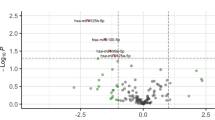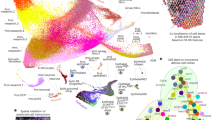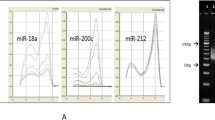Abstract
Background:
We currently do not know how the herbicide nitrofen induces lung hypoplasia and congenital diaphragmatic hernia in rats. Our aim was to compare the differentially expressed transcriptome of nitrofen-induced hypoplastic lungs to control lungs in embryonic day 13 rat embryos before the development of embryonic diaphragmatic defects.
Methods:
Using next-generation sequencing technology, we identified the expression profile of microRNA (miRNA) and mRNA genes. Once the dataset was validated by both RT-qPCR and digital-PCR, we conducted gene ontology, miRNA target analysis, and orthologous miRNA sequence matching for the deregulated miRNAs in silico.
Results:
Our study identified 186 known mRNA and 100 miRNAs which were differentially expressed in nitrofen-induced hypoplastic lungs. Sixty-four rat miRNAs homologous to known human miRNAs were identified. A subset of these genes may promote lung hypoplasia in rat and/or human, and we discuss their associations. Potential miRNA pathways relevant to nitrofen-induced lung hypoplasia include PI3K, TGF-β, and cell cycle kinases.
Conclusion:
Nitrofen-induced hypoplastic lungs have an abnormal transcriptome that may lead to impaired development.
Similar content being viewed by others
Log in or create a free account to read this content
Gain free access to this article, as well as selected content from this journal and more on nature.com
or
References
Inui M, Martello G, Piccolo S. MicroRNA control of signal transduction. Nat Rev Mol Cell Biol 2010;11:252–63.
Yates LA, Norbury CJ, Gilbert RJ. The long and short of microRNA. Cell 2013;153:516–9.
Johar D, Siragam V, Mahood TH, Keijzer R. New insights into lung development and diseases : the role of microRNAs. 2015;10:1–10.
Keijzer R, Puri P. Congenital diaphragmatic hernia. Semin Pediatr Surg 2010;19:180–5.
van Loenhout RB, Tibboel D, Post M, Keijzer R. Congenital diaphragmatic hernia: comparison of animal models and relevance to the human situation. Neonatology 2009;96:137–49.
Manson JM. Mechanism of nitrofen teratogenesis. Environ Health Perspect 1986;70:137–47.
Allan DW, Greer JJ. Pathogenesis of nitrofen-induced congenital diaphragmatic hernia in fetal rats. J Appl Physiol (1985) 1997;83:338–47.
Keijzer R, Liu J, Deimling J, Tibboel D, Post M. Dual-hit hypothesis explains pulmonary hypoplasia in the nitrofen model of congenital diaphragmatic hernia. Am J Pathol 2000;156:1299–306.
Kent WJ, Sugnet CW, Furey TS, et al. The human genome browser at UCSC. Genome Res 2002;12:996–1006.
Mi H, Muruganujan A, Thomas PD. PANTHER in 2013: modeling the evolution of gene function, and other gene attributes, in the context of phylogenetic trees. Nucleic Acids Res 2013;41 (Database issue):D377-86.
Kanehisa M, Goto S, Sato Y, Kawashima M, Furumichi M, Tanabe M. Data, information, knowledge and principle: back to metabolism in KEGG. Nucleic Acids Res 2014;42 (Database issue):D199–205.
Kozomara A, Griffiths-Jones S. MiRBase: annotating high confidence microRNAs using deep sequencing data. Nucleic Acids Res 2014;42:88–91.
Bhaskaran M, Wang Y, Zhang H, et al. MicroRNA-127 modulates fetal lung development. Physiol Genomics 2009;37:268–78.
Houbaviy HB, Murray MF, Sharp PA. Embryonic stem cell-specific microRNAs. Dev Cell 2003;5:351–8.
Ambros V, Bartel B, Bartel DP, et al. A uniform system for microRNA annotation. RNA 2003;9:277–9.
Hassan F, Nuovo GJ, Crawford M, et al. MiR-101 and miR-144 regulate the expression of the CFTR chloride channel in the lung. PLoS One 2012;7 (11): e50837.
Xie C, Jiang XH, Zhang JT, et al. CFTR suppresses tumor progression through miR-193b targeting urokinase plasminogen activator (uPA) in prostate cancer. Oncogene 2013;32:2282–91, 2291.e1–7.
Pandit KV, Corcoran D, Yousef H, et al. Inhibition and role of let-7d in idiopathic pulmonary fibrosis. Am J Respir Crit Care Med 2010;182:220–9.
Johnson SM, Grosshans H, Shingara J, et al. RAS is regulated by the let-7 microRNA family. Cell 2005;120:635–47.
Davis-Dusenbery BN, Chan MC, Reno KE, et al. Down-regulation of Kruppel-like factor-4 (KLF4) by microRNA-143/145 is critical for modulation of vascular smooth muscle cell phenotype by transforming growth factor-beta and bone morphogenetic protein 4. J Biol Chem 2011;286:28097–110.
Guilbert TW, Gebb SA, Shannon JM. Lung hypoplasia in the nitrofen model of congenital diaphragmatic hernia occurs early in development. Am J Physiol Lung Cell Mol Physiol 2000;279:L1159–71.
Chinoy MR, Chi X, Cilley RE. Down-regulation of regulatory proteins for differentiation and proliferation in murine fetal hypoplastic lungs: altered mesenchymal–epithelial interactions. Pediatr Pulmonol 2001;32:129–41.
Tong QS, Zheng LD, Tang ST, et al. Nitrofen suppresses cell proliferation and promotes mitochondria-mediated apoptosis in type II pneumocytes. Acta Pharmacol Sin 2007;28:672–84.
Jin FG, Li WP, Mu DG, et al. Joint application of 7 interventional pulmonology methods in early diagnosis of lung cancer. Zhonghua Yi Xue Za Zhi 2009;89:1667–71.
Halappanavar S, Wu D, Williams A, et al. Pulmonary gene and microRNA expression changes in mice exposed to benzo(a)pyrene by oral gavage. Toxicology 2011;285:133–41.
Bao W, Holt LJ, Prince RD, et al. Novel fusion of GLP-1 with a domain antibody to serum albumin prolongs protection against myocardial ischemia/reperfusion injury in the rat. Cardiovasc Diabetol 2013;12:148.
Popova AP, Bozyk PD, Goldsmith AM, et al. Autocrine production of TGF-beta1 promotes myofibroblastic differentiation of neonatal lung mesenchymal stem cells. Am J Physiol Lung Cell Mol Physiol 2010;298:L735–43.
Jesudason EC, Smith NP, Connell MG, et al. Peristalsis of airway smooth muscle is developmentally regulated and uncoupled from hypoplastic lung growth. Am J Physiol Lung Cell Mol Physiol 2006;291:L559–65.
Wang B, Herman-Edelstein M, Koh P, et al. E-cadherin expression is regulated by miR-192/215 by a mechanism that is independent of the profibrotic effects of transforming growth factor-beta. Diabetes 2010;59:1794–802.
Gregory PA, Bert AG, Paterson EL, et al. The miR-200 family and miR-205 regulate epithelial to mesenchymal transition by targeting ZEB1 and SIP1. Nat Cell Biol 2008;10:593–601.
Xu C, Chen ZX, Liu WY, Wang YX, Xiong ZX. A series of observation on the expression of TGF-beta1 in the lung of nitrofen-induced congenital diaphragmatic hernia rat model. Zhonghua Wai Ke Za Zhi 2009;47:301–4.
Massaro D, Massaro GD. Invited Review: pulmonary alveoli: formation, the “call for oxygen,” and other regulators. Am J Physiol Lung Cell Mol Physiol 2002;282:L345–58.
Chen MH, MacGowan A, Ward S, Bavik C, Greer JJ. The activation of the retinoic acid response element is inhibited in an animal model of congenital diaphragmatic hernia. Biol Neonate 2003;83:157–61.
Pavez Loriè E, Li H, Vahlquist A, Törmä H. The involvement of cytochrome p450 (CYP) 26 in the retinoic acid metabolism of human epidermal keratinocytes. Biochim Biophys Acta 2009;1791:220–8.
Beurskens LW, Tibboel D, Lindemans J, et al. Retinol status of newborn infants is associated with congenital diaphragmatic hernia. Pediatrics 2010;126:712–20.
Weiss FU, Marques IJ, Woltering JM, et al. Retinoic acid receptor antagonists inhibit miR-10a expression and block metastatic behavior of pancreatic cancer. Gastroenterology 2009;137:2136–45.e1–7.
Volpe MV, Martin A, Vosatka RJ, Mazzoni CL, Nielsen HC. Hoxb-5 expression in the developing mouse lung suggests a role in branching morphogenesis and epithelial cell fate. Histochem Cell Biol 1997;108:495–504.
Ma L, Teruya-Feldstein J, Weinberg RA. Tumour invasion and metastasis initiated by microRNA-10b in breast cancer. Nature 2007;449:682–8.
Tang H, Hornstein E, Stolovich M, et al. Amino acid-induced translation of TOP mRNAs is fully dependent on phosphatidylinositol 3-kinase-mediated signaling, is partially inhibited by rapamycin, and is independent of S6K1 and rpS6 phosphorylation. Mol Cell Biol 2001;21:8671–83.
Doi T, Ruttenstock E, Dingemann J, Puri P. Spatiotemporal alteration in phosphatidylinositide 3-kinase-serine/threonine protein kinase B signaling in the nitrofen-induced hypoplastic lung. J Pediatr Surg 2010;45:366–71.
Janssen WJ, McPhillips KA, Dickinson MG, et al. Surfactant proteins A and D suppress alveolar macrophage phagocytosis via interaction with SIRP alpha. Am J Respir Crit Care Med 2008;178:158–67.
Robinson MD, McCarthy DJ, Smyth GK. edgeR: a bioconductor package for differential expression analysis of digital gene expression data. Bioinformatics 2010;26:139–40.
Zhu E, Zhao F, Xu G, et al. mirTools: microRNA profiling and discovery based on high-throughput sequencing. Nucleic Acids Res 2010;38 (Web Server issue):W392–7.
Gerlach D, Kriventseva EV, Rahman N, Vejnar CE, Zdobnov EM. miROrtho: computational survey of microRNA genes. Nucleic Acids Res 2009;37 (Database issue):D111–7.
Ye J, Coulouris G, Zaretskaya I, Cutcutache I, Rozen S, Madden TL. Primer-BLAST: a tool to design target-specific primers for polymerase chain reaction. BMC Bioinformatics 2012;13:134.
Notredame C, Higgins DG, Heringa J. T-Coffee: a novel method for fast and accurate multiple sequence alignment. J Mol Biol 2000;302:205–17.
Acknowledgements
We would like to thank Dr. Deborah Tsuyuki, Manager of the Next Generation Sequencing Platform at the Children’s Hospital Research Institute of Manitoba for her technical assistance. This work was supported by a small grant from the Children’s Hospital Research Institute of Manitoba. Richard Keijzer holds a career enhancement award from the Canadian Child Health Clinician Scientist Program and a New Investigator Salary Award from the Canadian Institutes of Health Research and Manitoba Lung Association/Children’s Hospital Research Institute of Manitoba.
Author information
Authors and Affiliations
Corresponding author
Supplementary information
Supplementary Figure S1
(PDF 2391 kb)
Supplementary Figure S2
(PDF 2949 kb)
Supplementary Figure S3
(PDF 5474 kb)
Supplementary Tables
(DOC 1017 kb)
Rights and permissions
About this article
Cite this article
Mahood, T., Johar, D., Iwasiow, B. et al. The transcriptome of nitrofen-induced pulmonary hypoplasia in the rat model of congenital diaphragmatic hernia. Pediatr Res 79, 766–775 (2016). https://doi.org/10.1038/pr.2015.277
Received:
Accepted:
Published:
Issue date:
DOI: https://doi.org/10.1038/pr.2015.277
This article is cited by
-
MIF inhibition enhances pulmonary angiogenesis and lung development in congenital diaphragmatic hernia
Pediatric Research (2019)



